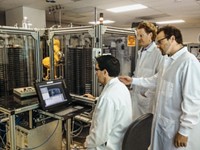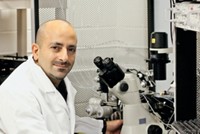Advertisement
Grab your lab coat. Let's get started
Welcome!
Welcome!
Create an account below to get 6 C&EN articles per month, receive newsletters and more - all free.
It seems this is your first time logging in online. Please enter the following information to continue.
As an ACS member you automatically get access to this site. All we need is few more details to create your reading experience.
Not you? Sign in with a different account.
Not you? Sign in with a different account.
ERROR 1
ERROR 1
ERROR 2
ERROR 2
ERROR 2
ERROR 2
ERROR 2
Password and Confirm password must match.
If you have an ACS member number, please enter it here so we can link this account to your membership. (optional)
ERROR 2
ACS values your privacy. By submitting your information, you are gaining access to C&EN and subscribing to our weekly newsletter. We use the information you provide to make your reading experience better, and we will never sell your data to third party members.
Business
Anatomy Of An Academic Drug Discovery Program
Inventing new medicines inside university walls requires complex funding and a highly collaborative research plan
by Lisa M. Jarvis
January 23, 2014
| A version of this story appeared in
Volume 92, Issue 3
To download a PDF of this article, go to http://cenm.ag/deal.
Academic institutions are increasingly formalizing their efforts to discover new drugs, often by establishing centers that bring together researchers and technology from across disciplines. As their ranks grow—the nonprofit Academic Drug Discovery Consortium now counts 94 centers as members—a question arises: What does it really take for an academic institution to invent a viable drug candidate?
To answer that question, C&EN looked at efforts by the Vanderbilt Center for Neuroscience Drug Discovery (VCNDD) to develop a series of small molecules to treat brain disorders. That program, ultimately licensed to AstraZeneca, reveals the complexity of assembling the funding and scientific know-how needed to bring an invention to the point that it can be handed off to an experienced drug developer.
The early-2013 deal with AstraZeneca for compounds acting on the M4 muscarinic acetylcholine receptor, a biological target relevant in schizophrenia and Alzheimer’s disease, was the culmination of eight years of work by the VCNDD team. The team’s research was supported by seven government grants that, along the way, generated 50 publications related to the biology and chemistry of modulating the M1 and M4 receptors.
Such success for an academic drug discovery center is impressive, but few have the resources of VCNDD. Formally established in 2007, the center has grown to include roughly 100 full-time employees. In 2013, VCNDD’s budget topped $20 million, more than half of which came from the National Institutes of Health. Corporate partners—which include AstraZeneca, Johnson & Johnson, and Bristol-Myers Squibb—contributed most of the rest.
VCNDD’s funding stream took years of thoughtful planning and intense teamwork to assemble. Also enabling the work were new grants introduced by NIH and an increased focus by the National Institute of Mental Health to support research that bridges basic science and drug development, according to VCNDD’s director, P. Jeffrey Conn.
Conn says his best advice for universities formalizing their drug discovery efforts is to avoid a contract research model, in which core facilities are available to individual researchers, in favor of a dedicated team of drug hunters. “It really does take a very focused team effort in which every member of the team is intellectually fully invested in—obsessing day and night about—the project,” Conn says.





Join the conversation
Contact the reporter
Submit a Letter to the Editor for publication
Engage with us on Twitter